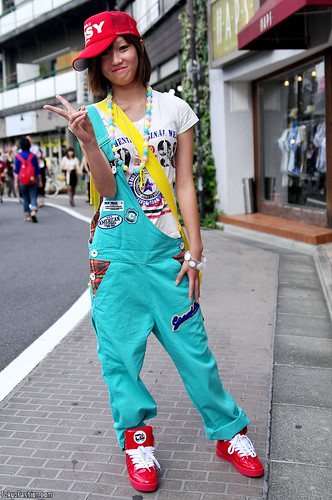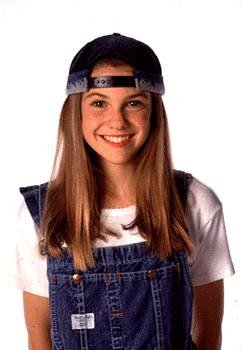 Nothing says en vogue quite like sporting the functional farmer wear du jour. To their credit, overalls did have a certain degree of versatility in the 90s: you had your traditional denim pair and then a few snazzier ones for special occasions. You know, like goat milking.
Nothing says en vogue quite like sporting the functional farmer wear du jour. To their credit, overalls did have a certain degree of versatility in the 90s: you had your traditional denim pair and then a few snazzier ones for special occasions. You know, like goat milking.Overalls inexplicably became a 90s must-have fashion item, prompting suburban kids who had never so much as visited a farm to covet these godforsaken garments. When I was in fourth grade, there was a style decree that on Thursdays, everyone wore overalls. It was sort of our elementary school version of Mean Girls' "On Wednesdays we wear pink". Anyone who was anyone in the fourth grade sure as hell better have showed up to school in overalls on Thursdays. Everyone knew that.
There were all sorts of fun self-expressing variations in overalls. Many 90s kids opted for the very popular one-strap-fastened-one-strap-unfastened look. It kind of said, sure, I like shoveling manure, but only sometimes. There was really no verifiable explanation for engaging in this half-fastened overall behavior as it served no functional purpose. If anything, it was pretty inconvenient to have a strap with an attached eye-piercing piece of metal swinging around your person all day.
If that wasn't for you, we had a little something for the ladies too. Overalls and sexiness may seem like two highly disparate concepts, but it was all in the shirt selection. If you were planning on wearing a shirt, that is. I got into many, many heated fights with my parents regarding the appropriateness of my wearing a lacy midriff-exposing tee shirt under my Gap overalls. If Kelly Kapowski could do it, then dammit why couldn't I? They've yet to give me a sufficient explanation for that one.
I tried to convince them that it could have been much, much, worse. There were girls up at the junior high showing up to school wearing just overalls and a smile. Okay, that's a total lie, those girls were more than likely surly as hell in their near-naked overalled state, but that's really neither here nor there.
 Looking back on this picture of Winona Ryder's near nakedness, I can sort of understand my parents' point of view. I do admire her strap-twisting prowess, though.
Looking back on this picture of Winona Ryder's near nakedness, I can sort of understand my parents' point of view. I do admire her strap-twisting prowess, though.Then of course we had the overall/flannel combo, a particular 90s fan favorite. There were many permutations on this highly versatile look, one of the most popular being the classic open-plaid-flannel-over-overalls look. It had a certain casual flair to it that we could all only aspire to achieve as child stylistas. Somewhat less body-flattering but equally widespread was the flannel tied around the waist of overalls look. If you had belt loops on your pair, you could even spice it up a bit and do some intricate woven work. Fancy stuff.
Or if you were into a little more pseudo-rebellion, the double unhooked look was also quite the rage. You may ask yourself why you'd choose to wear overalls if you didn't plan on utilizing their basic functionality, and you would most certainly be right to question this blatant idiocy. In fact, it would be much more convenient to simply don some sportswear separates, but these 90s kids just weren't having it. No, we'd throw on a belt to hold those babies up. No shame in that. Okay, a little shame. Alright, alright, loads of shame.
This particular style of overall wearing was a bit on the controversial side as it allegedly suggested gang affiliation. Indeed, it is still classified as such by many school districts. The Texas Youth Commission still defines the wearing "Overalls, unfastened" as potentially inflammatory behavior. I know, right. They helpfully explain the implications of gang wear as such:
The "gang look" is meant to intimidate those who are not in a gang. Children and teenagers who dress in clothing that resembles gang attire are showing an interest in gangs, will attract the attention of gangs, and could be putting themselves in extreme danger. In recent years children have been shot and killed by gangs simply for wearing gang related clothing. For the safety of your children, it is very important that you do not buy or allow your children to wear any item that gang members use to identify with the gang.
 Okay, Okay, so this is a Harajuku girl and not a gang member...but look at how her overalls conveniently only have a single strap! They've evolved!
Okay, Okay, so this is a Harajuku girl and not a gang member...but look at how her overalls conveniently only have a single strap! They've evolved!I'll agree with them that anyone killed for unintentionally wearing gang-themed clothing represents a terrible tragedy, but the tone of this is just absurd. If we thought authority figures were uncool in our day, it seems they've only tightened their grip with all sorts of new rules and regulations that were still in their larval stage during our formative years. It's all vaguely reminiscent of The Man trying to relate to young people but failing completely. It also brings to mind Daria's father Jake Morgendorffer, who once famously said, "I'm up on the issues. Is it a problem with your gang?"
No matter just how jiggy adults tried to be with our phat style, it seemed their condemnation only edged us further into the expanse of dangerous attire wearing. Many of the young people who so loved overalls had more or less never even heard of gangs, they just bought what The Gap told them to and that was that. And if The Gap told me to wear I've-been-working-on-the-railroad style pinstriped overalls, well, thus so it shall be.






